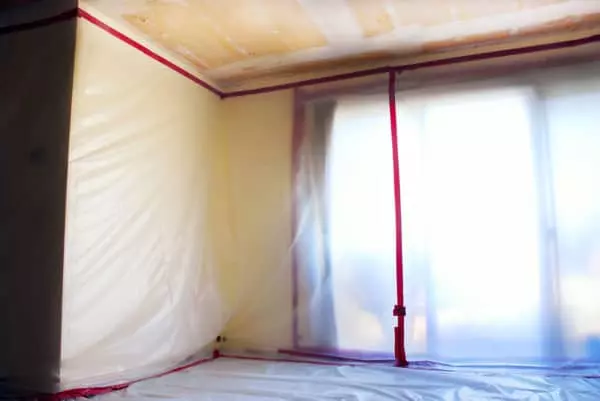
Stories about asbestos seem to be a permanent fixture in the news. Communities across the nation discover asbestos in various buildings and schools or hear about asbestos being improperly disposed of. It’s a serious threat that won’t disappear easily.
Asbestos cleanup projects occur frequently, and oftentimes seemingly right under a community’s nose. While the news might cover instances of what’s gone wrong or more major impacts of asbestos being found in a school, the average cleanup may not get any coverage at all.
Hearing about asbestos lurking nearby can cause some people to panic. After all, airborne asbestos can cause mesothelioma and other serious diseases. While there are strict laws in place federally, as well as on state and local levels, as to how asbestos must be handled and disposed of, the average citizen can also take their own measures to help ensure their loved ones stay safe and in-the-know.
Asbestos Removal Process
Asbestos abatement can range from a rather simple encapsulation job of undamaged asbestos-containing materials to the most dangerous removal where the asbestos has already been disturbed and become friable. These different classes of removal have their own regulations for how workers handle the job itself, as well as practices that must be followed to keep the workers safe from exposure.
These projects typically begin with an inspection by a certified professional. An inspector can assess the extent and condition of any asbestos-containing materials. The inspector can also perform an exposure assessment to determine the class of work and ensure all the proper precautions will occur at the asbestos work site.
According to the Occupational Safety & Health Administration (OSHA) regulations, monitoring on the sites is also necessary periodically to ensure acceptable permissible exposure limits (PEL) throughout the job’s entirety.
Each class of asbestos removal has different compliance measures, but in general these projects must remain covered and secured to the specific zone that has asbestos-containing materials. Workers must use wet methods to prevent asbestos fibers from becoming airborne while they work. Sweeping is prohibited, as this can circulate any particles or potentially spread the dust to other areas. Instead, only HEPA vacuums should be used for cleanup of that kind.
All of the materials must be safely contained after removal, as well as all equipment used and workers’ clothing to prevent contamination in areas outside of the work zone. Asbestos waste materials must be sealed in impermeable bags or containers and properly labeled. After the removal of the materials or encapsulation is complete, the area must be thoroughly cleaned and re-assessed to ensure the danger has been eliminated.
These removal standards will also ring true for homeowners of an older home that may contain asbestos. For homeowners who are considering renovations and are worried about asbestos, they should first contact qualified asbestos professionals to assess the situation.
Protections for the Community
While the OSHA standards mentioned above relate directly to the workers in the asbestos sites, these regulations and others can also help protect the public from possible exposure.
One of the main asbestos regulations in place to help prevent exposure is the Asbestos National Emission Standards for Hazardous Air Pollutants (NESHAP) under the Environmental Protection Agency. The NESHAP falls under the Clean Air Act and specifies work practices for any renovations or demolitions of any structures that contain a certain amount of asbestos, much like the OSHA regulations to protect employees.
Before any construction work can occur, these sites must notify the proper agency that ensures NESHAP is being followed, which is usually a state agency. The building owner will have to abide by any specified regulations for the cleanup and disposal of the asbestos.
Unfortunately, some states follow only the basic guidelines of NESHAP for these projects. At a minimum, there will be a thorough inspection of the site and detailed work practices to control asbestos emissions. There are many states though that have developed additional regulations to further protect workers and the community. For example, California heavily regulates asbestos in terms of its use, how it affects air quality, and its removal.
Communities can also be more aware of construction projects going on, since asbestos cleanups must be marked. These regulated areas must have appropriate signage around the work zone itself as well as outside the space to protect others from potential exposure and minimize contact with the space. The signs must be visible and easily understood. Per law, the signs must state: “DANGER / ASBESTOS CANCER AND LUNG DISEASE HAZARD / AUTHORIZED PERSONNEL ONLY / RESPIRATORY AND PROTECTIVE CLOTHING ARE REQUIRED IN THIS AREA”

Communication and awareness are key for the safety of everyone in these asbestos cleanups. It’s extremely easy for exposure to occur, and no amount of exposure to the toxin is considered safe. Building owners and asbestos professionals must carefully abide by these guidelines to protect themselves and others.
Steps You Can Take
While there are strict laws in place to protect both workers and the general public, that doesn’t mean shady business practices don’t ever occur. For example, earlier this year a news story came out about an asbestos professional falsifying documentation on an abatement job. We can take steps to help protect ourselves from asbestos during these cleanups.
Be Informed: As they always say, knowledge is power. Learning about the dangers of asbestos and proper practices around its removal can help protect you and your loved ones from any ongoing asbestos cleanup. Keeping up with upcoming or ongoing construction projects in older buildings and schools in your hometown can also help you stay on top of any potential asbestos threat. Some state and local government sites will also give citizens the means to look up ongoing asbestos projects in the area.
Know Your Rights: Being aware of your legal rights when it comes to asbestos can help you take extra precaution and help ensure these projects are being handled properly. If you live or work in a building that contains asbestos, your landlord or employer should inform you of its presence and where it’s located. They should provide reports on its condition and any plans for construction or repairs. When any renovation will occur, tenants must be informed, as well.
Additionally, schools that contain asbestos must have an abatement management plan in place by law. You can request to see the plan at any time that you might have concerns and it must be shown within 5 days of such a request.
Raise Awareness: Use your voice in your community and beyond to help protect others. Being aware of asbestos is an important aspect of preventing mesothelioma and other deadly diseases. Teaching others about the toxin and where to find it can save a life.
While asbestos is more strictly regulated than it used to be, until it is finally banned and removed, it’s remains a serious threat we all must be more vigilant of.




